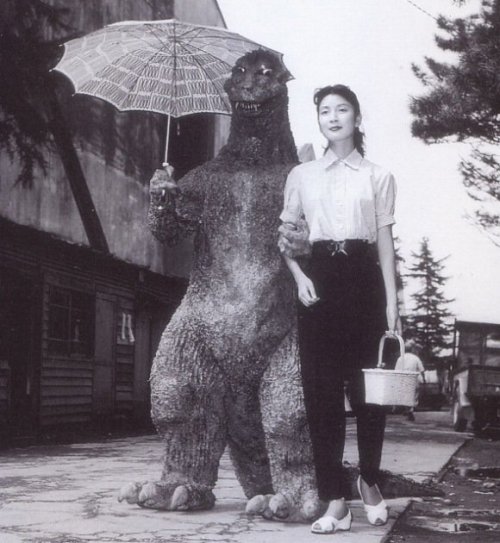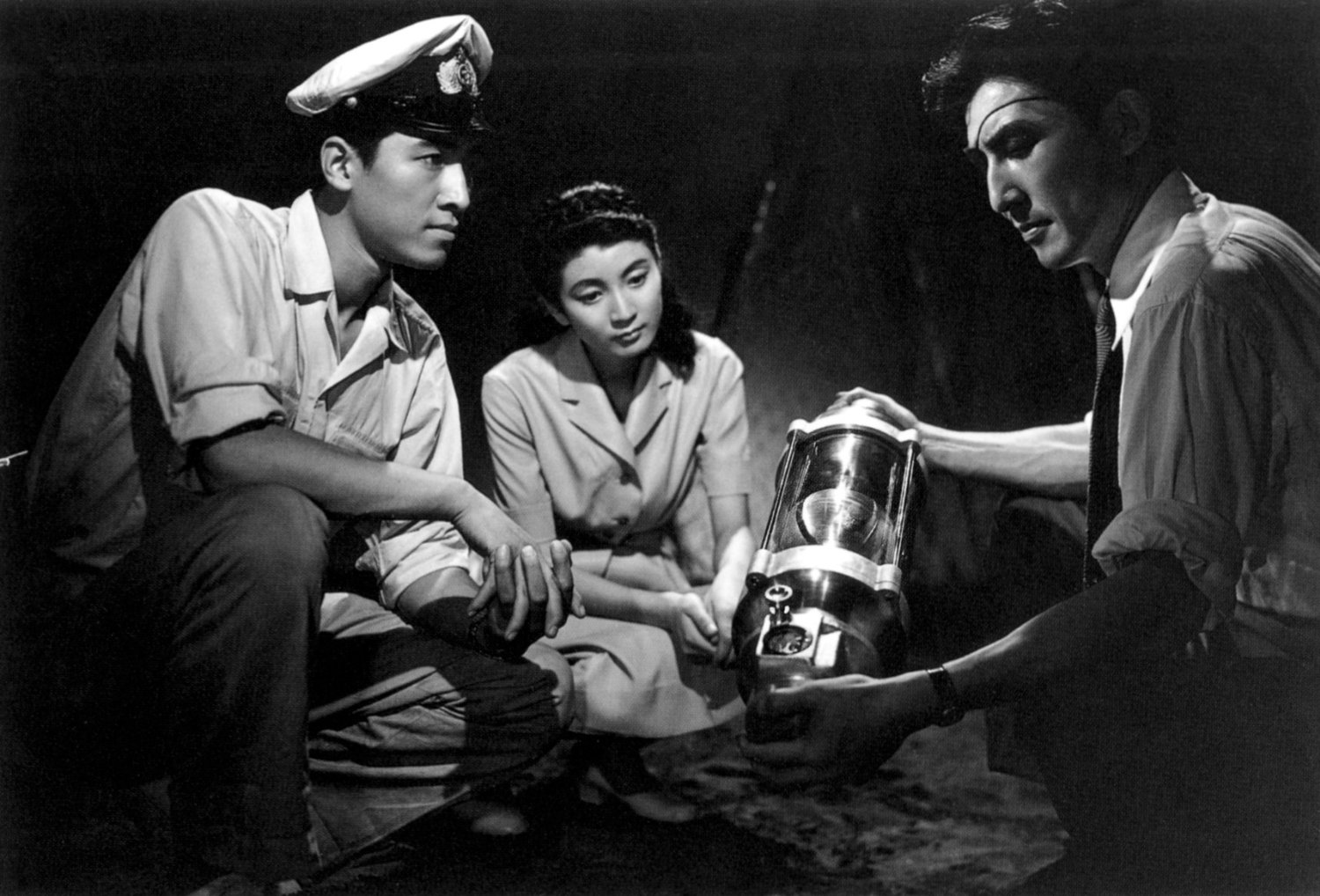Okay, here we are 63 days until Gareth Edwards' Godzilla hits theatres and today we're looking at the movie that started it all: 1954's Gojira.
Japanese fishing boats begin disappearing near Odo Island, prompting the local shipping company to launch an investigation to try and figure out what happened. As ships keep disappearing, a few survivors wash up on Odo Island, only to die immediately after, although one says that the ships are being sunk by a monster. When a group of reporters witness the destruction first hand while investigating on Odo Island, a research team is sent to try and determine what is really going on. It turns out that the dead sailor was right and a 50 meter tall monster the island elders call "Gojira" (American translation is "Godzilla") is to blame. More investigation uncovers that Gojira was created by the radiation from nuclear weapons. Soon, the creature arrives in Tokyo and both the military and Tokyo's residents realize that the creature is as powerful as the nuclear tests that spawned him, putting the fate of their country (and possibly the world) at stake.
Classic image of Gojira/Godzilla wreaking havoc.
Okay, background! On August 6th, 1945, the Allied Forces dropped an atomic bomb on the town of Hiroshima, Japan after the United States called for a surrender of Japanese Forces in the last stages of World War II, threatening "prompt and utter destruction" if they didn't. Three days after Hiroshima was bombed, another Japanese city, Nagasaki, received the same treatment. Japan would then announce its surrender to the Allied Forces on August 15th and sign the instrument of surrender on September 2nd, thus ending World War II. Not surprisingly, the horrors of such events have never truly gone away and the events were still fresh in director Ishiro Honda & producer Tomoyuki Tanaka's memories when they began work on Gojira. The film has a background story as interesting as the film itself, as this was supposed to be a completely different project altogether, but that project fell apart and Toho Studios just said, "Guys, you have production time to use, just make a movie. Any movie!" Tanaka had recently read of the Daigo Fukuryū Maru (The Lucky Dragon), a fishing boat that had been exposed to radiation by the thermonuclear device test in the Bikini Atoll in March 1st, 1954 and was inspired by the American film The Beast From 20,000 Fathoms (rightfully so, damn good film) to bring in the monster-movie angle. Sci-fi novelist Shigeru Kayama wrote the original story while Honda and Takeo Murata wrote the screenplay. Toho held a contest to determine the name of the monster, the winner being "Gojira," a combination of the Japanese words for gorilla and whale. I could go on, but we got a movie to review!
Haruo Nakajima (in suit) and Momoko Kochi (Emiko) having fun on the set in 1954.
Okay, I'll admit it. I'd never seen this version of the film before, only the American 1956 version Godzilla: King Of The Monsters. Hell, there's a LOT of the Godzilla movies I still haven't seen. I had always wanted to see the original Japanese cut of the film but as a kid I was never able to find it. Just as well, because had I watched this version when I had the VHS of King Of The Monsters, I probably wouldn't appreciate Gojira and its themes as much as I do now. Most people see Gojira/Godzilla as something of a joke, a goofy cheap effect that does nothing but fight and smash other cheap effects. These kind of people need to sit down and watch Gojira, as this film is an allegory of the horrors of nuclear testing made by the people who experienced it first hand. The tone of this film is incredibly serious, treating Gojira's attack as if it were something akin to a natural disaster. With most of the other Godzilla films, if you see him crashing through a city obliterating civilization, you think to yourself, "Okay, just waiting for the other monster," or, "Look at the effects! LOL!" With Gojira, there's that feeling of hope being lost while looking at the burning skyline of Tokyo or as the military's defenses prove to be not even distractions to the creature as the intent was to show the creature as the atomic bomb personified. This was a tone that would be lost to the series for thirty years until 1984's Return Of Godzilla (or Godzilla: 1985, if you're watching the American version).

This part, a woman holding her children amidst the rampage assuring her children they'll soon be reunited with their father in the afterlife, is especially haunting.
Now it's hard for me to tell if the actor's performances were good, scene chewing or whatever simply because this is an older film with (presumably) older acting styles and since the version I watched was Japanese audio with English subtitles, I spent more time reading the dialogue rather than taking in the intensity of any performances. That being said, I found the story flowed well, keeping the audience engaged in the characters enough that you aren't just looking down at your watch waiting for Gojira to arrive. The creature doesn't reveal itself until about 28 minutes into the film (if I recall correctly) and those 28 minutes are not a chore to sit through. I do not recall if the love triangle between Emiko, Hideto Ogata (Akira Takarada) and Dr. Daisuke Serizawa (Akihiko Hirata) was in the King Of The Monsters version, but it didn't feel forced here, providing a path to a crucial plot development that could save humanity but destroy it alike. I also was glad to see that not every person was all for obliterating Gojira on sight (despite the sense it would make). Emiko's father, Dr. Kyohei Tamane (Takashi Shimura) flat out asks the question, "Instead of simply trying to find ways of killing it, why don't we focus on what's keeping it alive?" These questions go on unheard, but blame a guy for trying. Perhaps if he had actually gotten his paleontology right earlier in the film, people would've been more likely to listen (dinosaurs roaming the Earth two million years ago? What kind of scientist are you?).
Gojira easily working his way through Tokyo's electric defense.
Background history of the film? Check. Acting and character discussion? Brief, but check, so let's talk effects. You might think that there wouldn't be much to say about a guy in a suit stepping on miniatures, but you'd be wrong. Being in the Gojira suit was apparently Hell. First off, the very first suit that was made was so heavy and stiff that it proved unusable. Even with the redesigned suit, Nakajima would overheat and become very dehydrated and exhausted, actually passing out at one point. Even with a valve to drain sweat from the suit, the Gojira suit could only be worn for three minutes to avoid suffocation (makes Mark "Crash" McCreary & John Rosengrant's experiences in the Jurassic Park Velociraptor suits sound downright pleasant). However, Nakajima must've exuded enough testosterone to throw a Herculian laugh at these setbacks as he continued to portray the creature until he retired in 1972. At first the idea was tossed around to film Gojira in color, but Toho said "Eff that," because they wanted the nighttime attacks on Tokyo to give Gojira a more frightening and mysterious look, shrouding many of his details in darkness and (in my opinion, anyway) preventing the audience from getting a truly great look at the monster in full detail. At it turns out, filming in black and white also hid some of the wires used in the effects shots and making it feel less like you're watching a guy in a rubber suit and more like you're seeing the story as it unfolds.
Ogata, Emiko & Serizawa with the device to use against Gojira.
I'm not saying that I'm doing cartwheels saying that this is the best movie ever, but there's little doubt why fans will swear up, down, left, right and center that this is the best film in the Godzilla series and quite possibly the best kaiju (Japanese for "giant beast") film. I'm used to this film gaining nothing but praise, so I found it surprising when I learned that upon its initial release in Japan, Gojira was received with rather nasty feedback, accusing the film of cashing in on the misery that their homeland had incurred during World War II as well as the Diago Fukuryu Maru incident, labeling it, as Honda told Tokyo Journal, "Grotesque junk, something that you'd spit up," much like how I've said why I'll never watch World Trade Center. Despite the initial negativity towards the film, Gojira would go on to win the 1954 Japan Movie Association Award for Special Effects and be nominated for Best Picture, only to lose to Seven Samurai, which, from what I've heard, is nothing to be ashamed of. Thankfully, as time went on, Japan (and the rest of the world) would grow to appreciate the film more and it reached such popularity that it went on to spawn an astonishing 27 sequels in Japan alone, not to mention the American releases of Godzilla: King Of The Monsters, the 1998 trainwreck by Roland Emmerich & Dean Devlin and, of course, the upcoming Gareth Edwards' version. The monster's legacy is not limited to film either as there are multiple games, novels and comics sporting the giant monster.
Including a recent arc from IDW featuring a cameo from the 1998 creature, which I still like. The creature, I mean. Screw the movie.
Gojira is one of those movies that its hard to talk about without sounding like you're just parroting what has already been said about it, but at the same time, it's fucking Gojira. If you consider yourself a kaiju fan in any way, shape or form, go watch this movie as the kaiju genre would be nothing without it. Perhaps one day I'll watch both this and Godzila: King Of The Monsters to compare the two.
Well, I hope you enjoyed reading my take on the classic Gojira. As fun as it would be to pull a Cinemassacre and review every Godzilla film ever made, a) it's been done and b) many of them have a more light hearted tone than what I feel the upcoming film will have. Check back later as we jump forward thirty years and look at the direct sequel and beginning of the Heisei series, The Return Of Godzilla.
-The Cynic






No comments:
Post a Comment